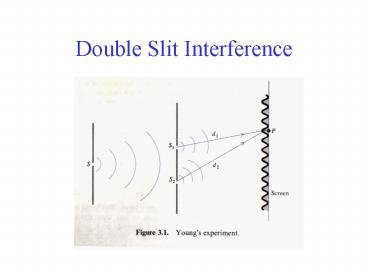Double Slit Interference - PowerPoint PPT Presentation
Title:
Double Slit Interference
Description:
ray 1 is reflected from a medium with slower speed ... Both rays reflected from media in which ... black ray has extra phase difference of due to reflection ... – PowerPoint PPT presentation
Number of Views:49
Avg rating:3.0/5.0
Title: Double Slit Interference
1
Double Slit Interference
2
Intensity of Double Slit
E E1 E2
I E2 E12 E22 2 E1 E2 I1 I2
interference lt vanishes if incoherent
3
Refraction
- In general v ?f and ? changes if v does
- in vacuum c ?f
- in a medium c/n ?nf
- hence ?n ?/n which is less than ?
- consider two light waves which are in phase in
air (n1) and each passes through a thickness L
of different material
upper wave has ?2 ?/n2
lower wave has ?1 ?/n1
4
Refraction
- Wave 2 has N2 L/?2 (L/?)n2 wavelengths
in block - Wave 1 has N1 L/?1 (L/?)n1 wavelengths
in block - hence N2 -N1 (L/?)(n2 -n1)
- phase change of wave 1 is k1x-?t (2?/?1)L
- ?t - phase change of wave 2 is k2x-?t (2?/?2)L
- ?t - phase difference (2?L/?)(n2 -n1) 2?(N2
-N1 )
5
Refraction
- Emerging waves are out of phase
- interfere constructively if phase difference is
2? x integer - (2?L/?)(n2 -n1) 2?m
- hence L m ?/(n2 -n1)
6
Problem
- Which pulse travels through the plastic in less
time?
7
Solution
- td/v
- pulse 2 tt1t2t3t4
- v1c/1.55, v2c/1.70, v3c/1.60, v4c/1.45
- t(L/c)( 1.551.701.601.45)6.30(L/c)
- pulse 1 t t1t2t3
- v1c/1.59, v2c/1.65, v3c/1.50
- t(L/c)(2 x 1.59 1.65 1.50)6.33(L/c)
- pulse 2 takes least time
8
Phase Change due to Reflection
- Soap films, oil slicks show interference effects
of light reflected from the top and bottom
surfaces
Why are there different colours?
Why does top portion of film appear dark?
- When a wave moves from one medium to another
there is a phase shift of ? if it moves more
slowly in the second medium and zero if it moves
more quickly
9
Fixed End
Phase change of ?
10
Free End
No phase change
11
- What is phase difference between rays 1 and 2 ?
- ray 2 travels further gt phase difference due to
path difference - phase difference due to extra thickness is
(2?/?)(2t) - but ? is the wavelength in the water medium!
? ?/n - ray 1 is reflected from a medium with slower
speed - ray 2 is reflected from a medium with higher
speed - extra phase difference of ? due to reflection of
ray 1 - total phase difference ? ? (2?n/?)(2t)
12
- Both rays reflected from media in which wave
moves more slowly - phase difference only due to path difference
- ? (2?nwater/?)(2t)
- if ? 2?m, then constructive interference
- if ? ? (2m-1), then destructive interference
- ? (2?nwater/?)(2t) ? (2m-1), i.e. t
(2m-1)(?/4nwater) - non-reflecting glass uses this principle
13
The diameters of fine wires can be accurately
measured using interference patterns. Two
optically flat pieces of glass of length L are
arranged with the wire between them as shown
above. The setup is illuminated by monochromatic
light, and the resulting interference fringes are
detected. Suppose L 20 cm and yellow sodium
light (?? 590 nm) is used for illumination. If 19
bright fringes are seen along this 20-cm
distance, what are the limits on the diameter of
the wire? Hint The nineteenth fringe might not
be right at the end, but you do not see a
twentieth fringe at all.
- 1. Find d for the 19th and 20th bright fringe
- path difference? black ray travels extra distance
2d in air gtphase diff (2?/?)(2d)
note n1! - black ray has extra phase difference of ? due to
reflection - bright fringe when ? (2?/?)(2d)?2?m gt
d(m-1/2)(?/2) - 2. Give the limits on d
- d19 (19 1/2) ? /2 5457 nm d20 5753
nm - hence 5.46 µm lt d lt 5.75 µm
14
Newtons Rings
Light reflected from curved lens interferes with
lift reflected from plate bright ring ???
(2?/?)(2d)2m? 2d(m-1/2) ? max































